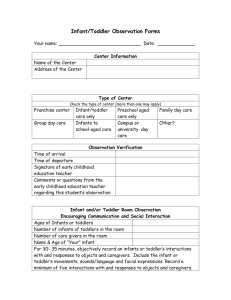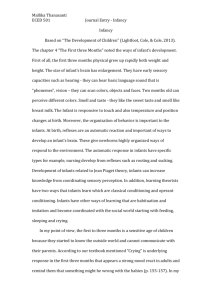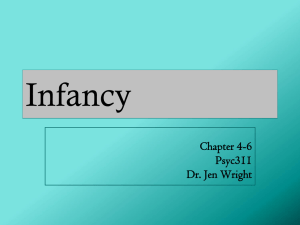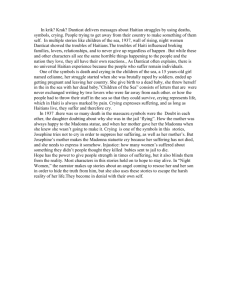Language
advertisement
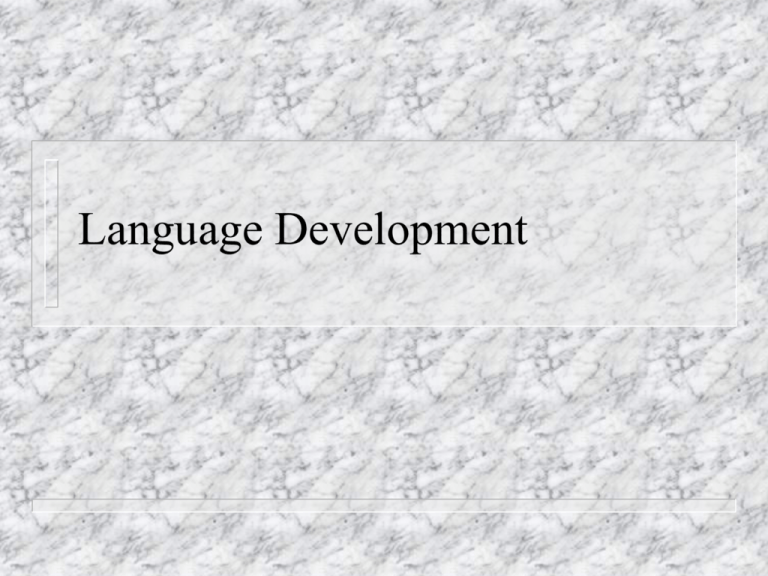
Language Development Some definitions n Language - a socially shared code or conventional system for representing concepts through use of arbitrary symbols and the rule governed combinations of those symbols – Speech - a verbal means of communicating or conveying meaning n Gestural precursors to speech – and gestural forms of speech Questions 1 n n n n List and describe the two functions of crying? List and describe the major stages of pre-speech vocalizations—phonation, cooing, expansion, canonical babbling, and integrative—using the audio samples from class as examples. What types of vocalizations are produced in the expansion stage, why might infants produce them, and what are infants doing in producing them that (most) other animals cannot do? What are characteristics of first words and what is the timetable for their emergence? Topics n n n n Crying Pre-linguistic speech First word acquisition The vocabulary spurt 4 Crying n Earliest vocalization –Curvilinear development n n n n n at birth cry 1-1 1/2 hrs/day 6 wks cry 2-4 hrs/day 12 wks crying decreases Individual differences in quantity Naturally occurring behavior – – – Then recruited for communication Continuum of intentionality Both directed and undirected crying still present at 12 months 5 Two crying functions n “[N]aturally occurring cry in 26 infants – n By 12 mo, most infants sometimes directed their crying toward the caregiver and elaborated the sounds by the use of gestures. – n n (aged 2.8-13.2 mo) and their mothers at home. But most continued to exhibit simple, undirected crying. Crying is both intentional and not intentional Shows increasing variability and sophistication in form and function. • Gustafson, G E.; Green, J A. Developmental coordination of cry sounds with visual regard and gestures. Infant Behavior & Development. 1991 Jan-Mar Vol 14(1) 51-57 6 Different acoustic patterns n Basic hunger cry – n Pain cry – n rhythmic pattern of loud crying, silence, inhalation loud, long shrill cry, then breath-holding silence Fake cry n low pitch and intensity, poorly articulated moans 7 Crying judgments n n n Adults have some capacity to distinguish Judgment depends on care giving context as well as acoustics Perceived aversiveness is important dimension of judgments about meaning of cries 8 Cries sound bad n n n There appears to be an underlying continuum of perceived aversiveness in young infants’ cries That can be predicted by their duration, dysphonation, and proportion of energy in various frequencies Parents and undergraduate non-parents perceive the cries as equally aversive. • Gustafson, G. E.; Green, J. A. ‘Acoustic features of cry perception: Infant development. ’Child Development. 1989 Aug Vol 60(4) 772-780 9 Prelinguistic speech n n Use of sounds in a communicative manner before speech (no words or grammar) Progress through stages culminating in speech-like vocalizations – Phonation, Gooing, Expansion, Canonical n Some overlap in vocalizations characteristic of stages • Kim Oller Phonation Stage, 0-2/3 months n n Vowel-like (“quasi-resonant”) Produced with normal speech like phonation involving vibration of the larynx but with the vocal tract at rest – n “comfort or pleasure” sounds - can sound like grunts The infant’s tongue almost completely fills the mouth limiting the sounds newborns can make Cooing/Gooing Stage, 1 - 4 months n Still vowel-like – – n more guttural & throaty – n /e/ & /u/ but last longer produced in the back of the vocal cavity thought to be precursors to consonants – /k/ /g/ Expansion Stage, 3 - 8 months n Isolated vowel-like sounds – – n Usually produced with the mouth open Full vowels (“fully resonant nuclei”) Vocal repertoire expands dramatically n n Infant experiments with sound production, varying pitch, volume, & rate Intentional communicative play – Already beyond pre-set animal calls n – Which have set form and set causes Infant vocalizes for pleasure (just to have fun) or displeasure Checking out the new sound system n Yells/whispers: playing with amplitude/intensity n n Squeals & Growls: playing with pitch – n squeals = high pitch, growls = low pitch Raspberries – labial trill & vibrants n n yells = high intensity, whispers = low intensity Cannot transcribe as adult syllables Marginal babbles – – – consonant-vowel (CV) sequences the transition between C & V is slow and drawn out immature syllables Oller, K. 15 Functional flexibility of infant vocalization. Oller, et al. 2013. PNAS n ‘Three types of infant vocalizations (squeals, vowel-like sounds, and growls) express a full range of emotional content— positive, neutral, and negative by 3–4 mos. – Contrast: cry and laughter are species-specific signals apparently homologous to vocal calls in other primates, show functional stability, with cry overwhelmingly expressing negative and laughter positive emotional states.’ 16 ‘Functional flexibility is a sine qua non in spoken language n Appears before syntax, word learning, and even joint attention, syllable imitation, and canonical babbling. The appearance of functional flexibility early in the first year of human life is a critical step in the development of vocal language and may have been a critical step in the evolution of human language, preceding protosyntax and even primitive single words.’ 17 Canonical Babbling Stage, 6-10 mos n CV sequences – n Transition between CV are crisp – – n /ma/ /da/ /ada/ Sounds like natural syllables in parent’s language Parents good at identifying this stage Reduplicated babbling – /baba/ /dadada/ /mama/ Importance of Babbling n Involves increasing control over the articulatory mechanism Important pre-speech developmental milestone n Should be present by 10 months! n – – Occurs in Down Syndrome, premature, low SES kids and in all cultures But its delayed in hearing impaired infants and deaf children Limitations of Babbling n At end of stage, infants begin to use patterns or rising intonation that resemble adult speech – – – also known as gibberish, jargon, or conversational babbling It has intonation contours of language being learned Infants learn the music before the words n Does not refer (to objects, people, etc.) n Is not language 20 Integrative stage (9-18 months) n n n Beginning of meaningful speech Some mixing of babbled utterances and words Gibberish: (jargon) use of adult intonation patterns but what they say makes no sense – sounds like the child is having a conversation but you can’t understand what they are saying 21 First word definitions n Function – – – They are first words because they refer Arbitrary sound is paired with an object Often but not always nouns in the environment 22 First Word Characteristics n Form – – Conventional Typically brief n n n 1 syllable, e.g., ‘no’ or a reduplicated syllable, e.g., ‘ma-ma’ Most linguistically common words – – May be developed by babies And may be the easiest to articulate 23 First Word Timetable n Appear – – n Typically: 11 to 13 months Normal range: 10 to 14 months Normal variation – – 13 month vocabularies: 0 - 45 words Should have first word by 15 months n Screen for delay 24 First 50 words n Represent all of the major grammatical classes found in adult language - nouns: dog, cookie - verbs: down, up, eat - adjectives: hot, dirty - social words: yes, no, please - sound effects: meow, ouch, uh-oh 25 26 Cross-cultural differences in first words acquired 27 How words are learned n n Reference: Pairing of object names with objects Child must visually attend while label is provided – – – n So receptive joint attention helps Helps if parent labels what child is already looking at May be facilitated by routines Metalinguistic insights – – “Things have names” “I can make things happen with words” Corresponds to vocabulary spurt n Rapid, accelerating growth 28 Nouns n n Most common throughout language development Why do infants learn nouns most rapidly? – – Adults tend to label objects more than they label actions (fly, run) or describe objects (yellow crayon) Verbs are conceptually more complex; n nouns are concrete where verbs tend to be more abstract 29 Vocabulary Growth n Slow at first – n 18 month infant – n can take 3 or 4 months after first words to achieve a vocabulary or 10 to 30 words typically has a vocabulary of 50 words 18 - 22 months – – Vocabulary spurt From 50 to 300 words in few months 30 Meta-linguistic insights n Things have names” Corresponds to vocabulary spurt n n Rapid, accelerating growth “I can make things happen with words” – – Effort to express/understand participate Intentionality model (Bloom) n Language learning is effortful 31 Receptive and Expressive n 2 types of vocabulary development – Receptive - understands others’ words n n – n Say ‘bye-bye’. ‘Where’s Daddy?’ 13 months - 50 words Expressive - total words used (productive) Receptive typically outpaces expressive – Child understands more words than they use Individual Differences n 2 styles of language – Referential style - use language primarily to label objects in their environment n – Expressive style - use language as a means for engaging in social interaction n – E.g., dada, doggy, baba Hi, bye, ut-oh More kids have an expressive style although most have a combination 33 Syntax = grammar n Evidence of syntax – n Nonrandom combinations Development of syntax – Takes place with no explicit instruction. n n n Parents may teach new words but don’t teach syntax. `The emphasis is on what the child is saying rather than how the child says it. Innate or modeled? 34 Syntax of one word speech n Holophrase - a single word used to express complex meanings – – “Cookie” = “Give me the cookie” Early utterances are telegraphic n The essential words are used to convey whole ideas Syntax of 2 word sentences n Emerge – – 15 – 24 months, mean is 18 Usually have 50 words in vocabulary before combining words n n 7 months after their first words First sentences typically consist of nouns, verbs & adjectives – – Uses: name, locate, negate, question, etc. Pivot word n n frequently occurring word attached to a variety of other words More: Mommy, milk, hug 36 Common Errors n Underextension – – n Overextension – – n Word refers to particular exemplar “Car” = family’s car Word refers to inappropriately large class “Car” refers to all big things with wheels Interplay between two yields correct word usage Measuring grammatical development n n Mean length of utterance (MLU) is a measure of syntactic development. Average length of the child’s utterances is calculated in morphemes - NOT WORDS – a morpheme is the smallest unit of meaning in a word n n n n free morpheme: can stand as a word by itself (e.g., kind) bound morpheme: exists only within a word (e.g., -ly, -ness, s, -ed, ‘s) Each new morpheme reflects new linguistic knowledge. “I running” = 3 morphemes (not 2 words) 38 MLU length n n n n n Children who have similar MLUs are at the same level of linguistic maturity, and their language is at the same level of complexity. Children have MLUs of 1.0 to 2.0 1-2 years 2.0 to 3.0 2-3 years 3.0 to 4.0 3-4 years 39 Comprehension: Gogate 40 Comprehension: Gogate 41 Motherese/child directed speech n n n n Most adults can do it, infants prefer it Parents speak for children Parents stay a step ahead of child (scaffolding) Aids in teaching the child the norms of their culture & rules of their language – n cultural differences stem from mother’s styles of interactions and child rearing beliefs Has positive affect on early language development Infant directed speech n Slower rate, higher pitch, longer pauses – n Brief, grammatically correct sentences – n Use of simple syntax Key words at end & are spoken in a higher & louder voice – n Repetitive & reduplicated Diminutive used https://www.youtub e.com/watch?v=cSC – Objects may be over described XMfeo74Q Vocabulary is concrete Children’s early comprehension of syntax n Assessment methods involving action such as – – – – n diary studies (parents document conditions under which the child can or cannot understand) act-out tasks (in which the experimenter asks the child to act out a sentence using toys) direction tasks (in which the child is asked to carry out a direction, such as “tickle the duck”) picture-choice tasks (in which the child must select the picture that best represents the linguistic form being tested) Have limitations leading to confusion about children’s comprehension abilities. 44 The preferential looking paradigm n Has helped clear things up. – – – – – Used to assess language comprehension in infants as young as 12 months. Child watches two simultaneously presented videos. Child hears a statement describing one of the videos Record the amount of time the child spends watching each video Repeat 45 Child hears n “Cookie Monster is tickling Big Bird” – – n n n one screen showed Cookie Monster tickling Big Bird One screen showed Big Bird tickling Cookie Monster. Children at 17 months of age spent more time looking at the screen that matched the statement. Children can comprehend word order before they even begin using two-word sentences. Suggests that comprehension is indeed in advance of production, as parents have always known. 46 Statistical learning 47 48 Statistical rules Learning 49 How Is Language Learned? n Theories of language development Learning Theory n Language is learned through experience. Emphasis on role of child’s environment – Reinforcement ~ Parents reinforce or reward infants babbles that are approximations of real words (B.F. Skinner). n n shaping ~ children acquire early vocabularies through shaping or when parents require children’s utterances to be progressively closer to real words before reinforcement role of imitation ~ parents serve as models & children learn language in part through observation & imitation (Bandura) 51 Learning theory cannot explain: n n n why children spontaneously utter words or phrases they have never heard why there are invariant sequences of language development why there are spurts in language acquisition 52 Nativist Theory n Innate factors cause children to attend to & acquire language – Chomsky’s psycholinguistic theory n n Environmental regularities cannot account for the consistency of language acquisition. A neurally based language acquisition device is at work, enabling innate understanding of deep structure of language. Evidence for an inborn tendency: n Verbal function is localized in speech centers – – – – Typically in left cerebral hemisphere There is plasticity But it diminishes with age Sensitive period ~ proposed by Lennenberg; beginning at 18-24 months & lasting until puberty n n n neural development facilitates language learning Genie Universality of human languages – – – invariant sequences in development newborns respond to language regularity of early production of sounds Nativist theory does not explain: n n n variance in language skill & fluencey how children understand the meanings of words why language develops best when there is another person to communicate with 55 Review Syllabus 61


